B628: Problem Solving and Decision Making in Frank's Case Study
VerifiedAdded on 2023/04/24
|12
|3507
|448
Report
AI Summary
This report analyzes the case of Frank's business, exploring whether the problems he faced were bounded or unbounded, and how he attempted to solve them. It discusses the challenges related to increasing costs, outdated processes, and lack of visibility in inventory management. The report exa...
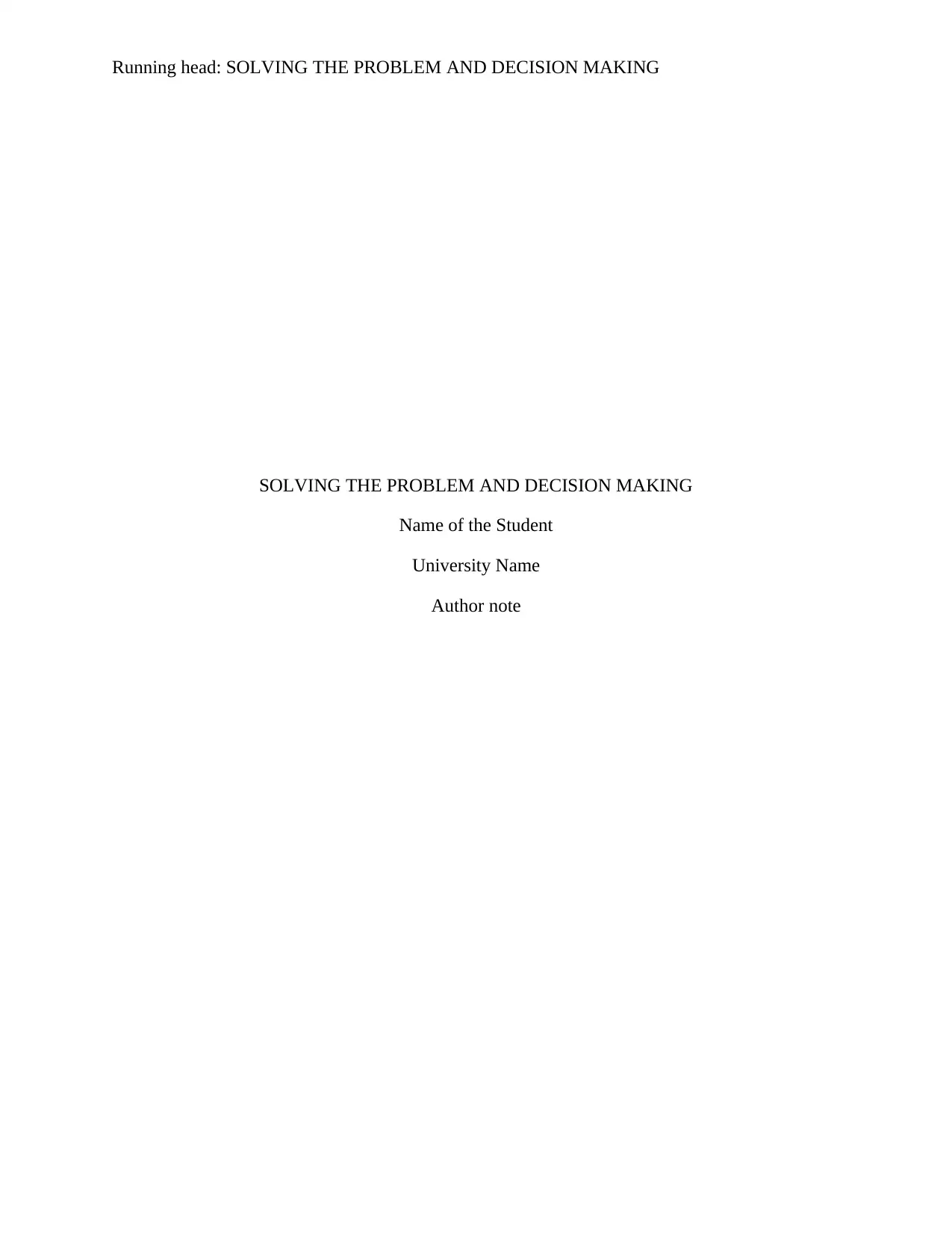
Running head: SOLVING THE PROBLEM AND DECISION MAKING
SOLVING THE PROBLEM AND DECISION MAKING
Name of the Student
University Name
Author note
SOLVING THE PROBLEM AND DECISION MAKING
Name of the Student
University Name
Author note
Secure Best Marks with AI Grader
Need help grading? Try our AI Grader for instant feedback on your assignments.
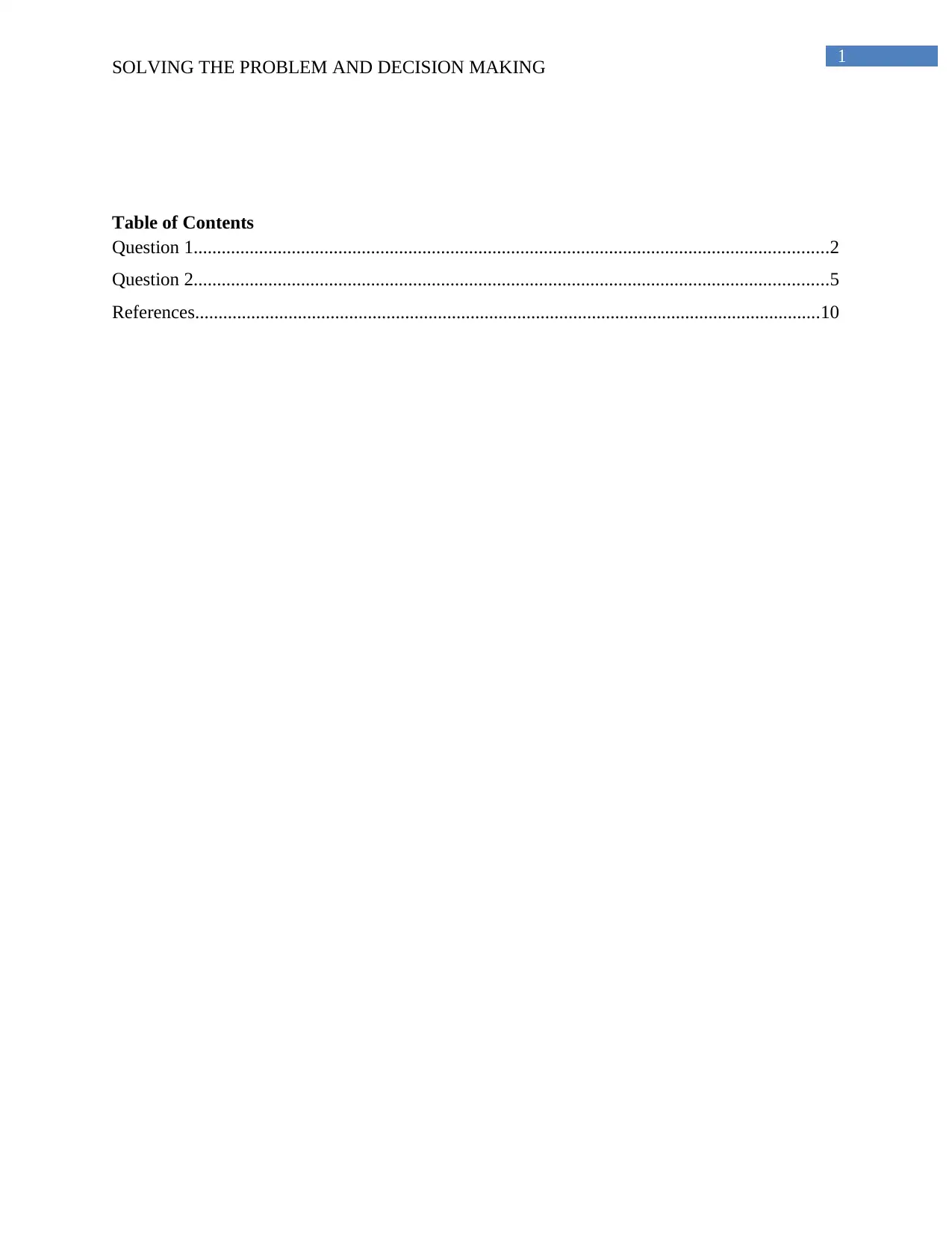
1
SOLVING THE PROBLEM AND DECISION MAKING
Table of Contents
Question 1........................................................................................................................................2
Question 2........................................................................................................................................5
References......................................................................................................................................10
SOLVING THE PROBLEM AND DECISION MAKING
Table of Contents
Question 1........................................................................................................................................2
Question 2........................................................................................................................................5
References......................................................................................................................................10
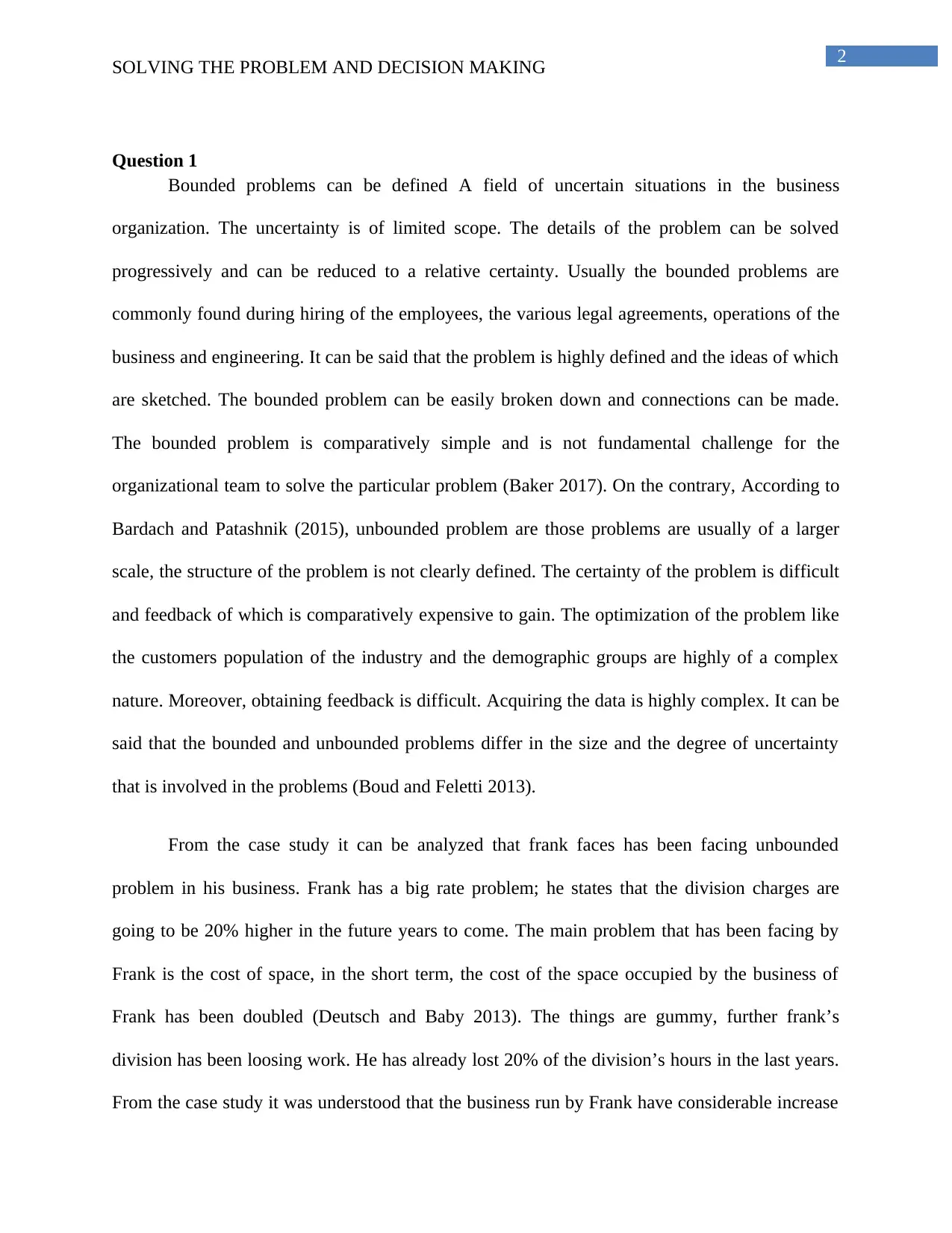
2
SOLVING THE PROBLEM AND DECISION MAKING
Question 1
Bounded problems can be defined A field of uncertain situations in the business
organization. The uncertainty is of limited scope. The details of the problem can be solved
progressively and can be reduced to a relative certainty. Usually the bounded problems are
commonly found during hiring of the employees, the various legal agreements, operations of the
business and engineering. It can be said that the problem is highly defined and the ideas of which
are sketched. The bounded problem can be easily broken down and connections can be made.
The bounded problem is comparatively simple and is not fundamental challenge for the
organizational team to solve the particular problem (Baker 2017). On the contrary, According to
Bardach and Patashnik (2015), unbounded problem are those problems are usually of a larger
scale, the structure of the problem is not clearly defined. The certainty of the problem is difficult
and feedback of which is comparatively expensive to gain. The optimization of the problem like
the customers population of the industry and the demographic groups are highly of a complex
nature. Moreover, obtaining feedback is difficult. Acquiring the data is highly complex. It can be
said that the bounded and unbounded problems differ in the size and the degree of uncertainty
that is involved in the problems (Boud and Feletti 2013).
From the case study it can be analyzed that frank faces has been facing unbounded
problem in his business. Frank has a big rate problem; he states that the division charges are
going to be 20% higher in the future years to come. The main problem that has been facing by
Frank is the cost of space, in the short term, the cost of the space occupied by the business of
Frank has been doubled (Deutsch and Baby 2013). The things are gummy, further frank’s
division has been loosing work. He has already lost 20% of the division’s hours in the last years.
From the case study it was understood that the business run by Frank have considerable increase
SOLVING THE PROBLEM AND DECISION MAKING
Question 1
Bounded problems can be defined A field of uncertain situations in the business
organization. The uncertainty is of limited scope. The details of the problem can be solved
progressively and can be reduced to a relative certainty. Usually the bounded problems are
commonly found during hiring of the employees, the various legal agreements, operations of the
business and engineering. It can be said that the problem is highly defined and the ideas of which
are sketched. The bounded problem can be easily broken down and connections can be made.
The bounded problem is comparatively simple and is not fundamental challenge for the
organizational team to solve the particular problem (Baker 2017). On the contrary, According to
Bardach and Patashnik (2015), unbounded problem are those problems are usually of a larger
scale, the structure of the problem is not clearly defined. The certainty of the problem is difficult
and feedback of which is comparatively expensive to gain. The optimization of the problem like
the customers population of the industry and the demographic groups are highly of a complex
nature. Moreover, obtaining feedback is difficult. Acquiring the data is highly complex. It can be
said that the bounded and unbounded problems differ in the size and the degree of uncertainty
that is involved in the problems (Boud and Feletti 2013).
From the case study it can be analyzed that frank faces has been facing unbounded
problem in his business. Frank has a big rate problem; he states that the division charges are
going to be 20% higher in the future years to come. The main problem that has been facing by
Frank is the cost of space, in the short term, the cost of the space occupied by the business of
Frank has been doubled (Deutsch and Baby 2013). The things are gummy, further frank’s
division has been loosing work. He has already lost 20% of the division’s hours in the last years.
From the case study it was understood that the business run by Frank have considerable increase
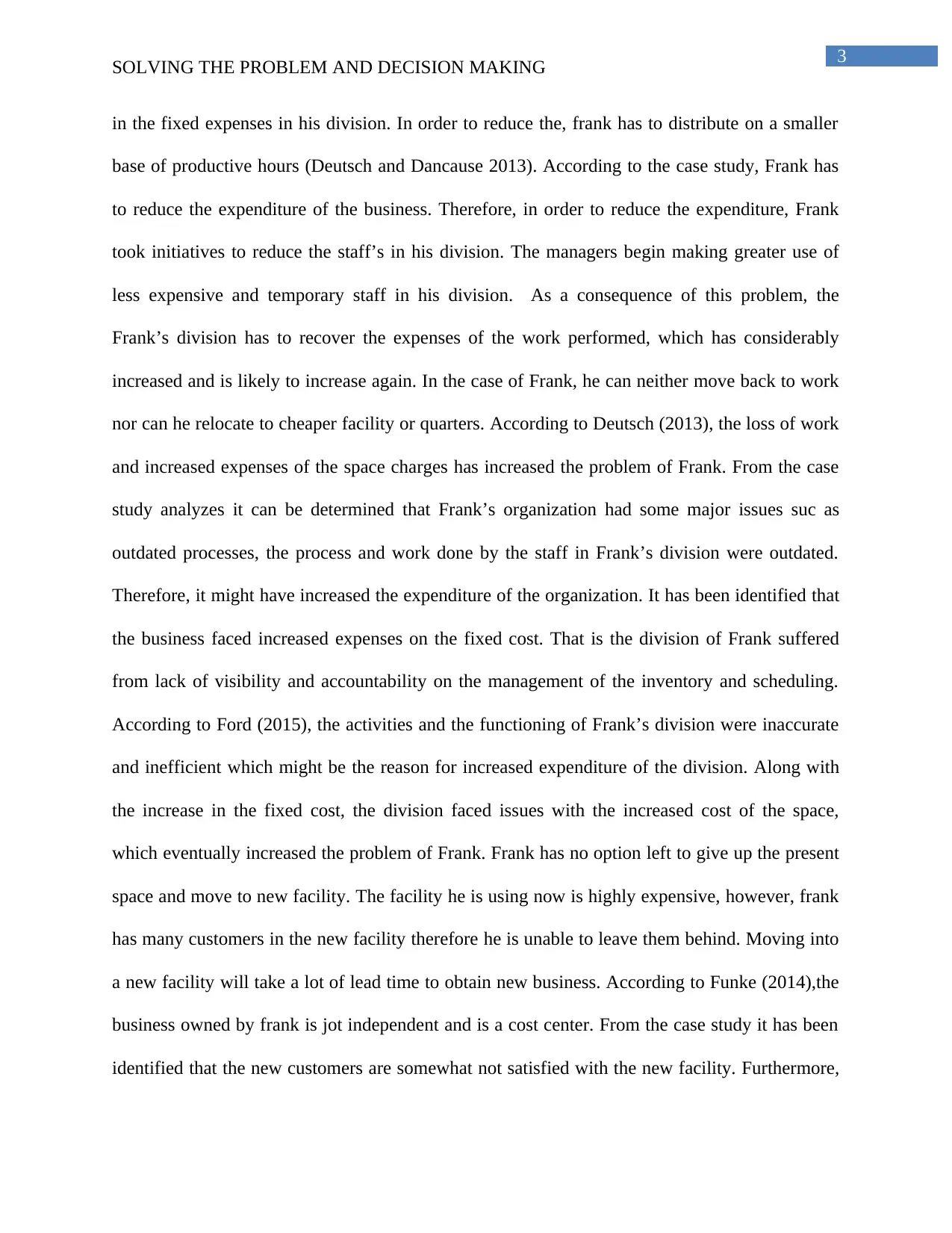
3
SOLVING THE PROBLEM AND DECISION MAKING
in the fixed expenses in his division. In order to reduce the, frank has to distribute on a smaller
base of productive hours (Deutsch and Dancause 2013). According to the case study, Frank has
to reduce the expenditure of the business. Therefore, in order to reduce the expenditure, Frank
took initiatives to reduce the staff’s in his division. The managers begin making greater use of
less expensive and temporary staff in his division. As a consequence of this problem, the
Frank’s division has to recover the expenses of the work performed, which has considerably
increased and is likely to increase again. In the case of Frank, he can neither move back to work
nor can he relocate to cheaper facility or quarters. According to Deutsch (2013), the loss of work
and increased expenses of the space charges has increased the problem of Frank. From the case
study analyzes it can be determined that Frank’s organization had some major issues suc as
outdated processes, the process and work done by the staff in Frank’s division were outdated.
Therefore, it might have increased the expenditure of the organization. It has been identified that
the business faced increased expenses on the fixed cost. That is the division of Frank suffered
from lack of visibility and accountability on the management of the inventory and scheduling.
According to Ford (2015), the activities and the functioning of Frank’s division were inaccurate
and inefficient which might be the reason for increased expenditure of the division. Along with
the increase in the fixed cost, the division faced issues with the increased cost of the space,
which eventually increased the problem of Frank. Frank has no option left to give up the present
space and move to new facility. The facility he is using now is highly expensive, however, frank
has many customers in the new facility therefore he is unable to leave them behind. Moving into
a new facility will take a lot of lead time to obtain new business. According to Funke (2014),the
business owned by frank is jot independent and is a cost center. From the case study it has been
identified that the new customers are somewhat not satisfied with the new facility. Furthermore,
SOLVING THE PROBLEM AND DECISION MAKING
in the fixed expenses in his division. In order to reduce the, frank has to distribute on a smaller
base of productive hours (Deutsch and Dancause 2013). According to the case study, Frank has
to reduce the expenditure of the business. Therefore, in order to reduce the expenditure, Frank
took initiatives to reduce the staff’s in his division. The managers begin making greater use of
less expensive and temporary staff in his division. As a consequence of this problem, the
Frank’s division has to recover the expenses of the work performed, which has considerably
increased and is likely to increase again. In the case of Frank, he can neither move back to work
nor can he relocate to cheaper facility or quarters. According to Deutsch (2013), the loss of work
and increased expenses of the space charges has increased the problem of Frank. From the case
study analyzes it can be determined that Frank’s organization had some major issues suc as
outdated processes, the process and work done by the staff in Frank’s division were outdated.
Therefore, it might have increased the expenditure of the organization. It has been identified that
the business faced increased expenses on the fixed cost. That is the division of Frank suffered
from lack of visibility and accountability on the management of the inventory and scheduling.
According to Ford (2015), the activities and the functioning of Frank’s division were inaccurate
and inefficient which might be the reason for increased expenditure of the division. Along with
the increase in the fixed cost, the division faced issues with the increased cost of the space,
which eventually increased the problem of Frank. Frank has no option left to give up the present
space and move to new facility. The facility he is using now is highly expensive, however, frank
has many customers in the new facility therefore he is unable to leave them behind. Moving into
a new facility will take a lot of lead time to obtain new business. According to Funke (2014),the
business owned by frank is jot independent and is a cost center. From the case study it has been
identified that the new customers are somewhat not satisfied with the new facility. Furthermore,
Secure Best Marks with AI Grader
Need help grading? Try our AI Grader for instant feedback on your assignments.
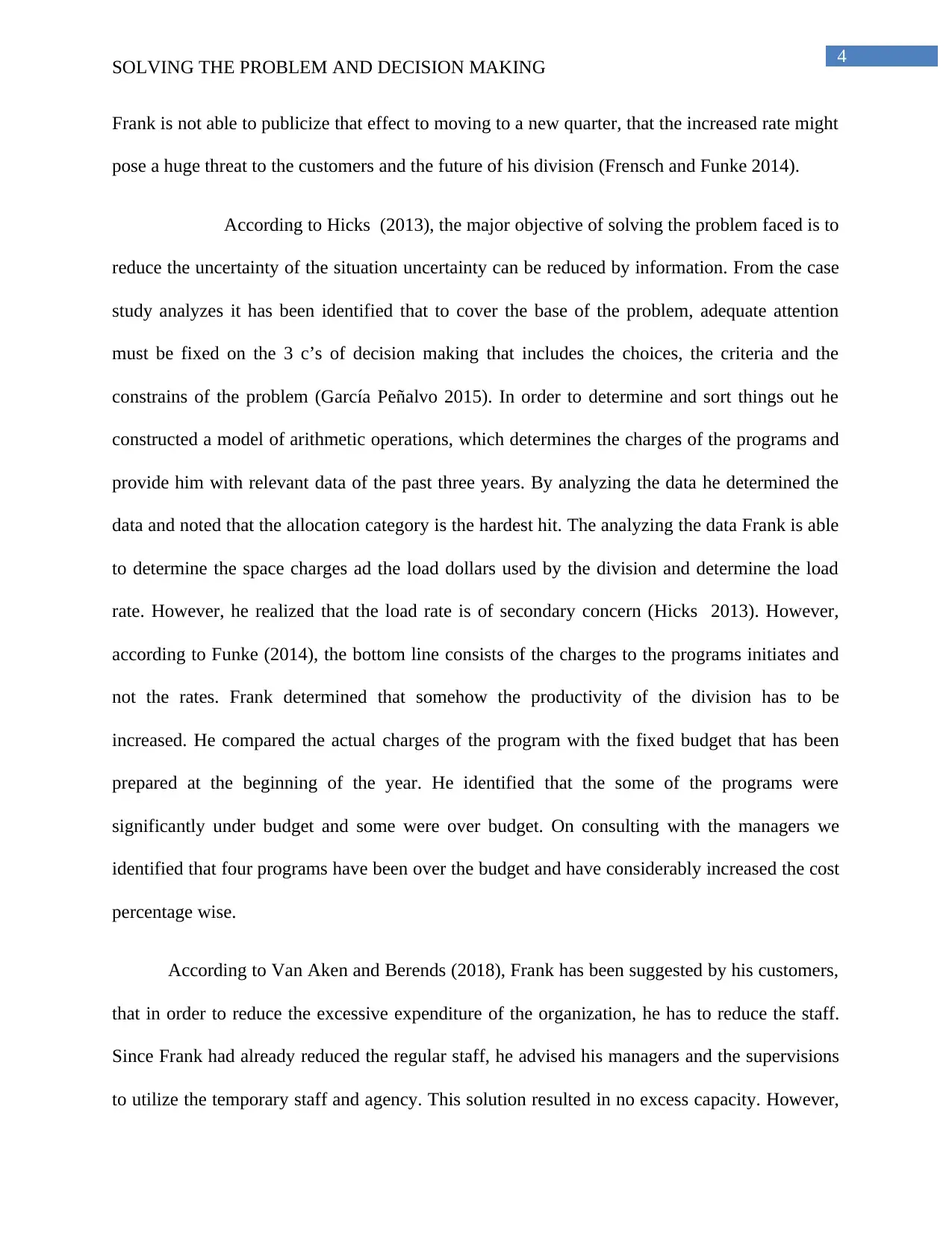
4
SOLVING THE PROBLEM AND DECISION MAKING
Frank is not able to publicize that effect to moving to a new quarter, that the increased rate might
pose a huge threat to the customers and the future of his division (Frensch and Funke 2014).
According to Hicks (2013), the major objective of solving the problem faced is to
reduce the uncertainty of the situation uncertainty can be reduced by information. From the case
study analyzes it has been identified that to cover the base of the problem, adequate attention
must be fixed on the 3 c’s of decision making that includes the choices, the criteria and the
constrains of the problem (García Peñalvo 2015). In order to determine and sort things out he
constructed a model of arithmetic operations, which determines the charges of the programs and
provide him with relevant data of the past three years. By analyzing the data he determined the
data and noted that the allocation category is the hardest hit. The analyzing the data Frank is able
to determine the space charges ad the load dollars used by the division and determine the load
rate. However, he realized that the load rate is of secondary concern (Hicks 2013). However,
according to Funke (2014), the bottom line consists of the charges to the programs initiates and
not the rates. Frank determined that somehow the productivity of the division has to be
increased. He compared the actual charges of the program with the fixed budget that has been
prepared at the beginning of the year. He identified that the some of the programs were
significantly under budget and some were over budget. On consulting with the managers we
identified that four programs have been over the budget and have considerably increased the cost
percentage wise.
According to Van Aken and Berends (2018), Frank has been suggested by his customers,
that in order to reduce the excessive expenditure of the organization, he has to reduce the staff.
Since Frank had already reduced the regular staff, he advised his managers and the supervisions
to utilize the temporary staff and agency. This solution resulted in no excess capacity. However,
SOLVING THE PROBLEM AND DECISION MAKING
Frank is not able to publicize that effect to moving to a new quarter, that the increased rate might
pose a huge threat to the customers and the future of his division (Frensch and Funke 2014).
According to Hicks (2013), the major objective of solving the problem faced is to
reduce the uncertainty of the situation uncertainty can be reduced by information. From the case
study analyzes it has been identified that to cover the base of the problem, adequate attention
must be fixed on the 3 c’s of decision making that includes the choices, the criteria and the
constrains of the problem (García Peñalvo 2015). In order to determine and sort things out he
constructed a model of arithmetic operations, which determines the charges of the programs and
provide him with relevant data of the past three years. By analyzing the data he determined the
data and noted that the allocation category is the hardest hit. The analyzing the data Frank is able
to determine the space charges ad the load dollars used by the division and determine the load
rate. However, he realized that the load rate is of secondary concern (Hicks 2013). However,
according to Funke (2014), the bottom line consists of the charges to the programs initiates and
not the rates. Frank determined that somehow the productivity of the division has to be
increased. He compared the actual charges of the program with the fixed budget that has been
prepared at the beginning of the year. He identified that the some of the programs were
significantly under budget and some were over budget. On consulting with the managers we
identified that four programs have been over the budget and have considerably increased the cost
percentage wise.
According to Van Aken and Berends (2018), Frank has been suggested by his customers,
that in order to reduce the excessive expenditure of the organization, he has to reduce the staff.
Since Frank had already reduced the regular staff, he advised his managers and the supervisions
to utilize the temporary staff and agency. This solution resulted in no excess capacity. However,
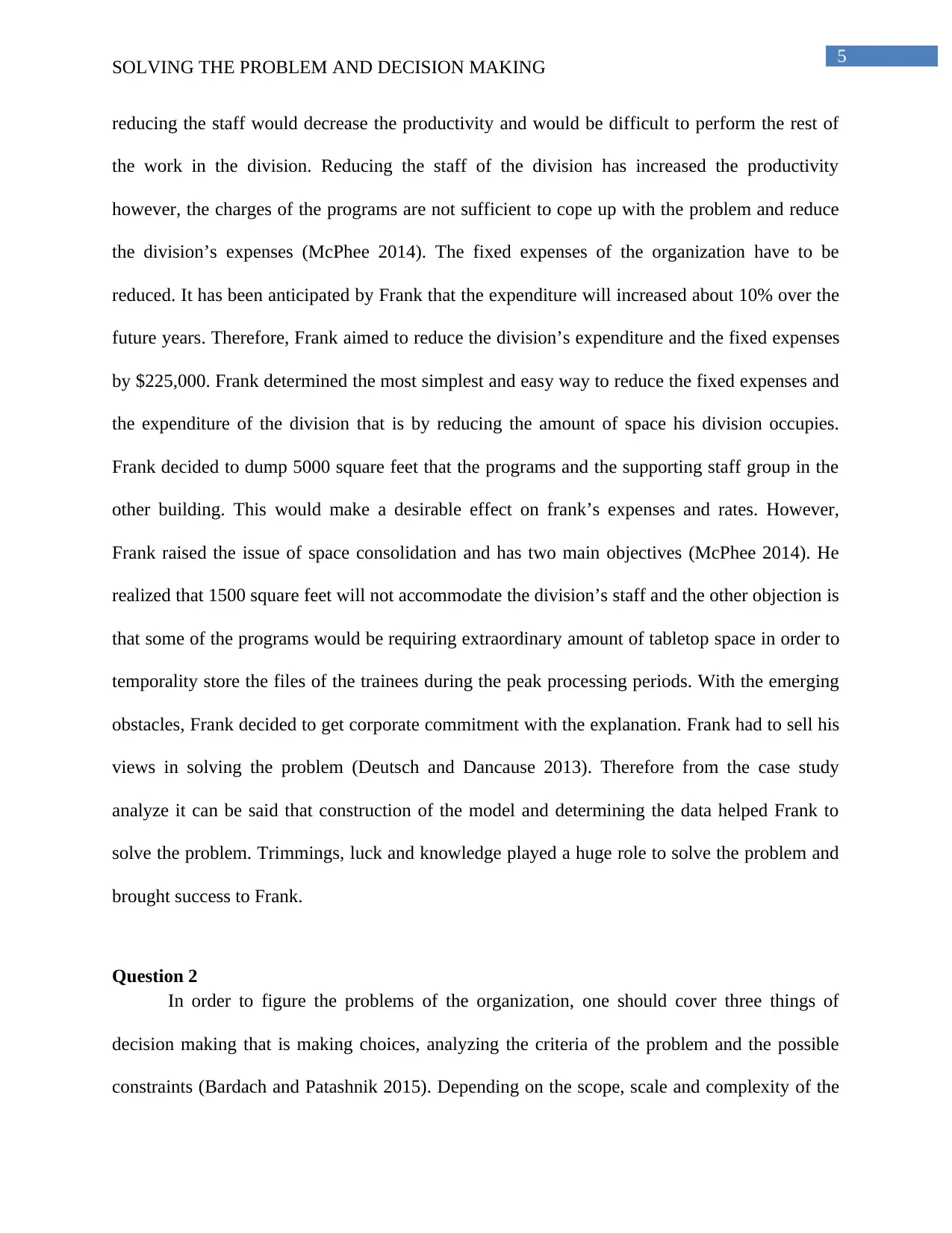
5
SOLVING THE PROBLEM AND DECISION MAKING
reducing the staff would decrease the productivity and would be difficult to perform the rest of
the work in the division. Reducing the staff of the division has increased the productivity
however, the charges of the programs are not sufficient to cope up with the problem and reduce
the division’s expenses (McPhee 2014). The fixed expenses of the organization have to be
reduced. It has been anticipated by Frank that the expenditure will increased about 10% over the
future years. Therefore, Frank aimed to reduce the division’s expenditure and the fixed expenses
by $225,000. Frank determined the most simplest and easy way to reduce the fixed expenses and
the expenditure of the division that is by reducing the amount of space his division occupies.
Frank decided to dump 5000 square feet that the programs and the supporting staff group in the
other building. This would make a desirable effect on frank’s expenses and rates. However,
Frank raised the issue of space consolidation and has two main objectives (McPhee 2014). He
realized that 1500 square feet will not accommodate the division’s staff and the other objection is
that some of the programs would be requiring extraordinary amount of tabletop space in order to
temporality store the files of the trainees during the peak processing periods. With the emerging
obstacles, Frank decided to get corporate commitment with the explanation. Frank had to sell his
views in solving the problem (Deutsch and Dancause 2013). Therefore from the case study
analyze it can be said that construction of the model and determining the data helped Frank to
solve the problem. Trimmings, luck and knowledge played a huge role to solve the problem and
brought success to Frank.
Question 2
In order to figure the problems of the organization, one should cover three things of
decision making that is making choices, analyzing the criteria of the problem and the possible
constraints (Bardach and Patashnik 2015). Depending on the scope, scale and complexity of the
SOLVING THE PROBLEM AND DECISION MAKING
reducing the staff would decrease the productivity and would be difficult to perform the rest of
the work in the division. Reducing the staff of the division has increased the productivity
however, the charges of the programs are not sufficient to cope up with the problem and reduce
the division’s expenses (McPhee 2014). The fixed expenses of the organization have to be
reduced. It has been anticipated by Frank that the expenditure will increased about 10% over the
future years. Therefore, Frank aimed to reduce the division’s expenditure and the fixed expenses
by $225,000. Frank determined the most simplest and easy way to reduce the fixed expenses and
the expenditure of the division that is by reducing the amount of space his division occupies.
Frank decided to dump 5000 square feet that the programs and the supporting staff group in the
other building. This would make a desirable effect on frank’s expenses and rates. However,
Frank raised the issue of space consolidation and has two main objectives (McPhee 2014). He
realized that 1500 square feet will not accommodate the division’s staff and the other objection is
that some of the programs would be requiring extraordinary amount of tabletop space in order to
temporality store the files of the trainees during the peak processing periods. With the emerging
obstacles, Frank decided to get corporate commitment with the explanation. Frank had to sell his
views in solving the problem (Deutsch and Dancause 2013). Therefore from the case study
analyze it can be said that construction of the model and determining the data helped Frank to
solve the problem. Trimmings, luck and knowledge played a huge role to solve the problem and
brought success to Frank.
Question 2
In order to figure the problems of the organization, one should cover three things of
decision making that is making choices, analyzing the criteria of the problem and the possible
constraints (Bardach and Patashnik 2015). Depending on the scope, scale and complexity of the
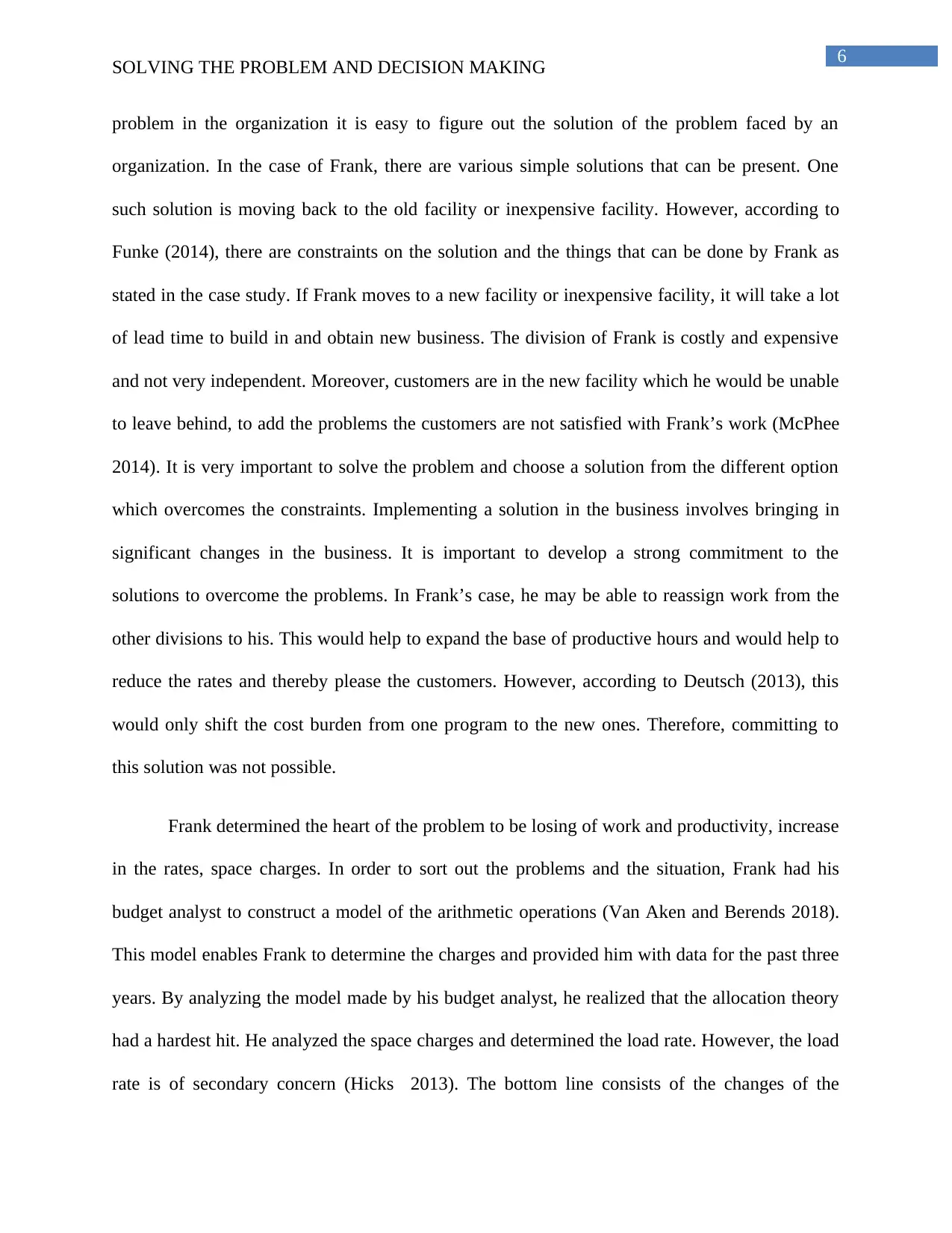
6
SOLVING THE PROBLEM AND DECISION MAKING
problem in the organization it is easy to figure out the solution of the problem faced by an
organization. In the case of Frank, there are various simple solutions that can be present. One
such solution is moving back to the old facility or inexpensive facility. However, according to
Funke (2014), there are constraints on the solution and the things that can be done by Frank as
stated in the case study. If Frank moves to a new facility or inexpensive facility, it will take a lot
of lead time to build in and obtain new business. The division of Frank is costly and expensive
and not very independent. Moreover, customers are in the new facility which he would be unable
to leave behind, to add the problems the customers are not satisfied with Frank’s work (McPhee
2014). It is very important to solve the problem and choose a solution from the different option
which overcomes the constraints. Implementing a solution in the business involves bringing in
significant changes in the business. It is important to develop a strong commitment to the
solutions to overcome the problems. In Frank’s case, he may be able to reassign work from the
other divisions to his. This would help to expand the base of productive hours and would help to
reduce the rates and thereby please the customers. However, according to Deutsch (2013), this
would only shift the cost burden from one program to the new ones. Therefore, committing to
this solution was not possible.
Frank determined the heart of the problem to be losing of work and productivity, increase
in the rates, space charges. In order to sort out the problems and the situation, Frank had his
budget analyst to construct a model of the arithmetic operations (Van Aken and Berends 2018).
This model enables Frank to determine the charges and provided him with data for the past three
years. By analyzing the model made by his budget analyst, he realized that the allocation theory
had a hardest hit. He analyzed the space charges and determined the load rate. However, the load
rate is of secondary concern (Hicks 2013). The bottom line consists of the changes of the
SOLVING THE PROBLEM AND DECISION MAKING
problem in the organization it is easy to figure out the solution of the problem faced by an
organization. In the case of Frank, there are various simple solutions that can be present. One
such solution is moving back to the old facility or inexpensive facility. However, according to
Funke (2014), there are constraints on the solution and the things that can be done by Frank as
stated in the case study. If Frank moves to a new facility or inexpensive facility, it will take a lot
of lead time to build in and obtain new business. The division of Frank is costly and expensive
and not very independent. Moreover, customers are in the new facility which he would be unable
to leave behind, to add the problems the customers are not satisfied with Frank’s work (McPhee
2014). It is very important to solve the problem and choose a solution from the different option
which overcomes the constraints. Implementing a solution in the business involves bringing in
significant changes in the business. It is important to develop a strong commitment to the
solutions to overcome the problems. In Frank’s case, he may be able to reassign work from the
other divisions to his. This would help to expand the base of productive hours and would help to
reduce the rates and thereby please the customers. However, according to Deutsch (2013), this
would only shift the cost burden from one program to the new ones. Therefore, committing to
this solution was not possible.
Frank determined the heart of the problem to be losing of work and productivity, increase
in the rates, space charges. In order to sort out the problems and the situation, Frank had his
budget analyst to construct a model of the arithmetic operations (Van Aken and Berends 2018).
This model enables Frank to determine the charges and provided him with data for the past three
years. By analyzing the model made by his budget analyst, he realized that the allocation theory
had a hardest hit. He analyzed the space charges and determined the load rate. However, the load
rate is of secondary concern (Hicks 2013). The bottom line consists of the changes of the
Paraphrase This Document
Need a fresh take? Get an instant paraphrase of this document with our AI Paraphraser
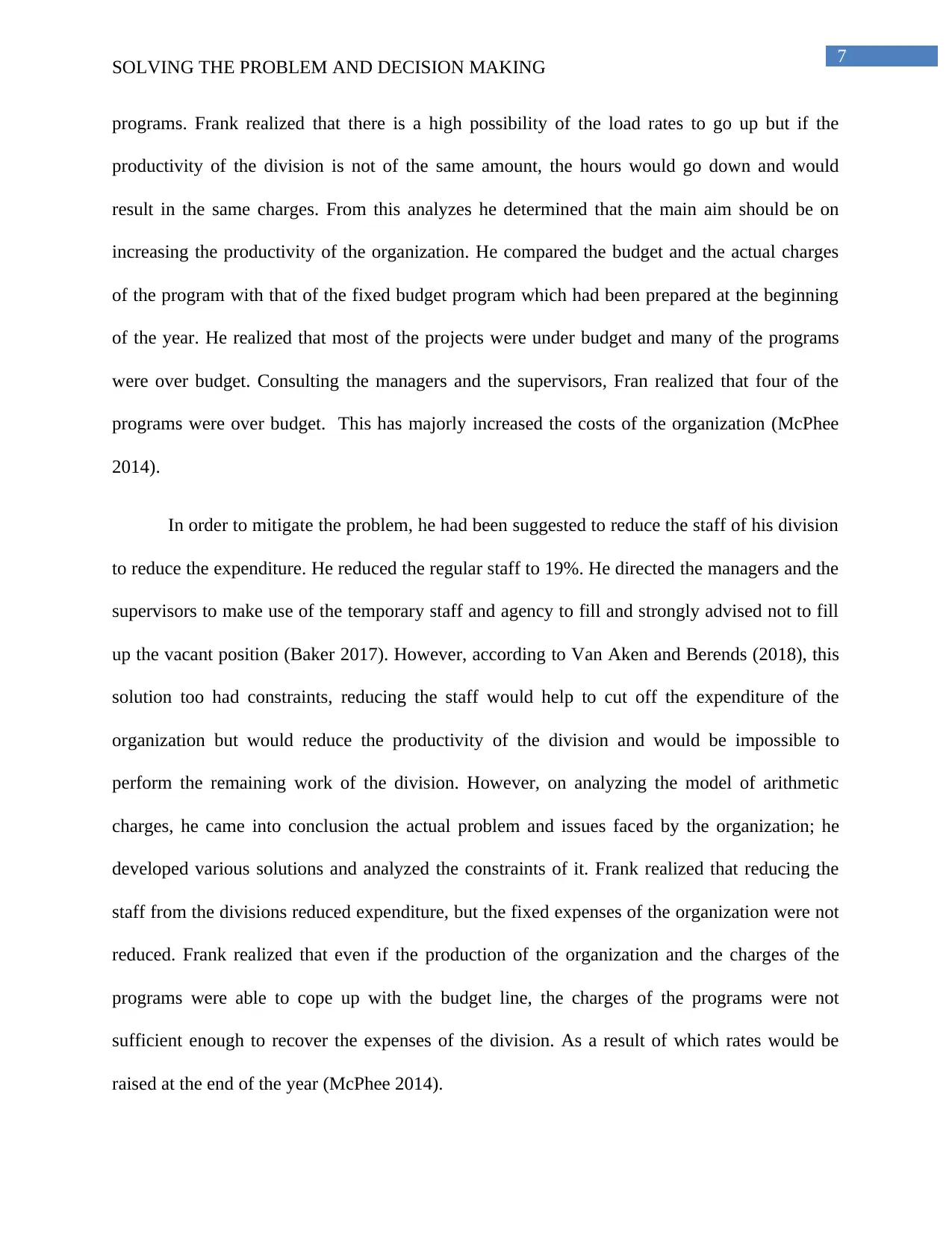
7
SOLVING THE PROBLEM AND DECISION MAKING
programs. Frank realized that there is a high possibility of the load rates to go up but if the
productivity of the division is not of the same amount, the hours would go down and would
result in the same charges. From this analyzes he determined that the main aim should be on
increasing the productivity of the organization. He compared the budget and the actual charges
of the program with that of the fixed budget program which had been prepared at the beginning
of the year. He realized that most of the projects were under budget and many of the programs
were over budget. Consulting the managers and the supervisors, Fran realized that four of the
programs were over budget. This has majorly increased the costs of the organization (McPhee
2014).
In order to mitigate the problem, he had been suggested to reduce the staff of his division
to reduce the expenditure. He reduced the regular staff to 19%. He directed the managers and the
supervisors to make use of the temporary staff and agency to fill and strongly advised not to fill
up the vacant position (Baker 2017). However, according to Van Aken and Berends (2018), this
solution too had constraints, reducing the staff would help to cut off the expenditure of the
organization but would reduce the productivity of the division and would be impossible to
perform the remaining work of the division. However, on analyzing the model of arithmetic
charges, he came into conclusion the actual problem and issues faced by the organization; he
developed various solutions and analyzed the constraints of it. Frank realized that reducing the
staff from the divisions reduced expenditure, but the fixed expenses of the organization were not
reduced. Frank realized that even if the production of the organization and the charges of the
programs were able to cope up with the budget line, the charges of the programs were not
sufficient enough to recover the expenses of the division. As a result of which rates would be
raised at the end of the year (McPhee 2014).
SOLVING THE PROBLEM AND DECISION MAKING
programs. Frank realized that there is a high possibility of the load rates to go up but if the
productivity of the division is not of the same amount, the hours would go down and would
result in the same charges. From this analyzes he determined that the main aim should be on
increasing the productivity of the organization. He compared the budget and the actual charges
of the program with that of the fixed budget program which had been prepared at the beginning
of the year. He realized that most of the projects were under budget and many of the programs
were over budget. Consulting the managers and the supervisors, Fran realized that four of the
programs were over budget. This has majorly increased the costs of the organization (McPhee
2014).
In order to mitigate the problem, he had been suggested to reduce the staff of his division
to reduce the expenditure. He reduced the regular staff to 19%. He directed the managers and the
supervisors to make use of the temporary staff and agency to fill and strongly advised not to fill
up the vacant position (Baker 2017). However, according to Van Aken and Berends (2018), this
solution too had constraints, reducing the staff would help to cut off the expenditure of the
organization but would reduce the productivity of the division and would be impossible to
perform the remaining work of the division. However, on analyzing the model of arithmetic
charges, he came into conclusion the actual problem and issues faced by the organization; he
developed various solutions and analyzed the constraints of it. Frank realized that reducing the
staff from the divisions reduced expenditure, but the fixed expenses of the organization were not
reduced. Frank realized that even if the production of the organization and the charges of the
programs were able to cope up with the budget line, the charges of the programs were not
sufficient enough to recover the expenses of the division. As a result of which rates would be
raised at the end of the year (McPhee 2014).
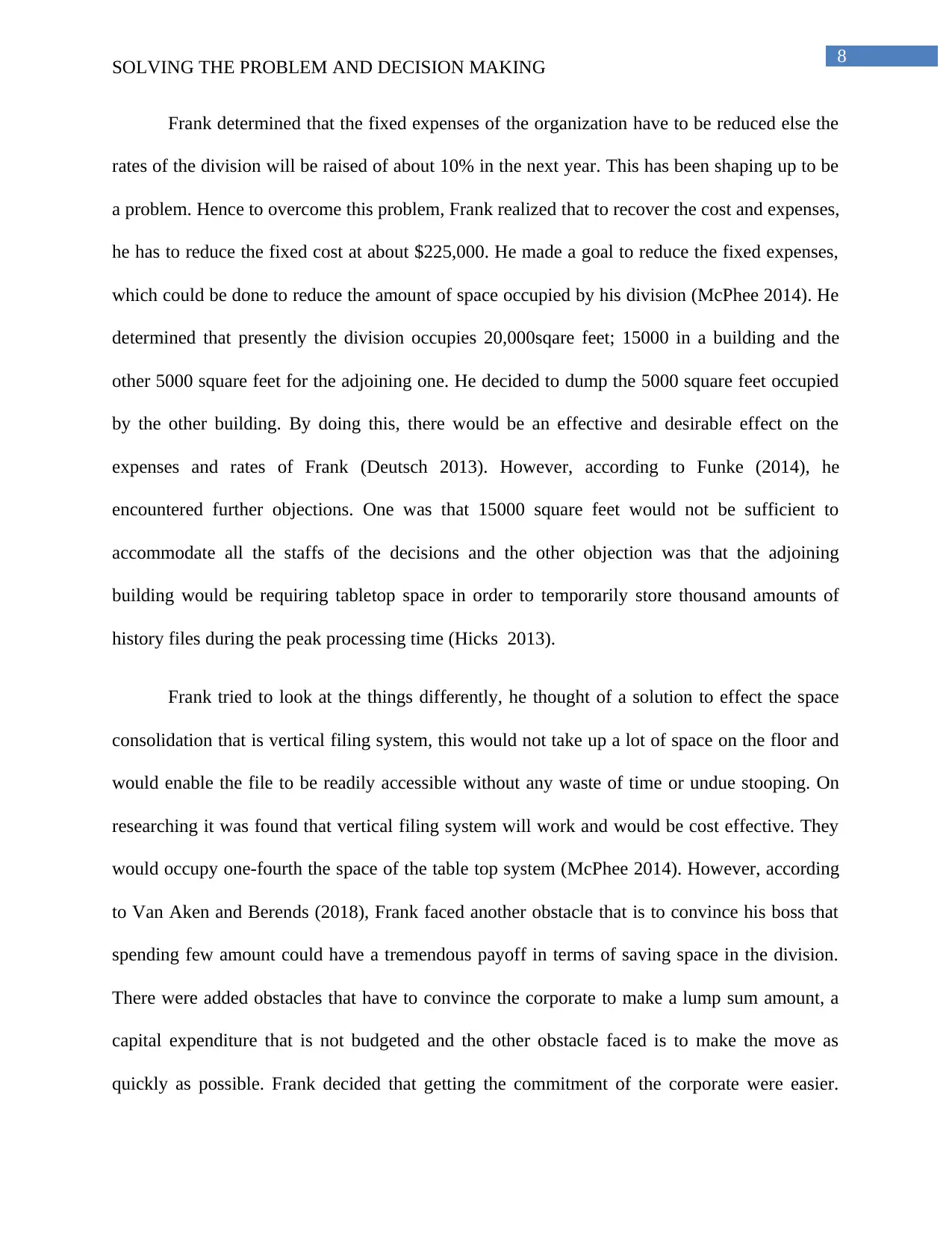
8
SOLVING THE PROBLEM AND DECISION MAKING
Frank determined that the fixed expenses of the organization have to be reduced else the
rates of the division will be raised of about 10% in the next year. This has been shaping up to be
a problem. Hence to overcome this problem, Frank realized that to recover the cost and expenses,
he has to reduce the fixed cost at about $225,000. He made a goal to reduce the fixed expenses,
which could be done to reduce the amount of space occupied by his division (McPhee 2014). He
determined that presently the division occupies 20,000sqare feet; 15000 in a building and the
other 5000 square feet for the adjoining one. He decided to dump the 5000 square feet occupied
by the other building. By doing this, there would be an effective and desirable effect on the
expenses and rates of Frank (Deutsch 2013). However, according to Funke (2014), he
encountered further objections. One was that 15000 square feet would not be sufficient to
accommodate all the staffs of the decisions and the other objection was that the adjoining
building would be requiring tabletop space in order to temporarily store thousand amounts of
history files during the peak processing time (Hicks 2013).
Frank tried to look at the things differently, he thought of a solution to effect the space
consolidation that is vertical filing system, this would not take up a lot of space on the floor and
would enable the file to be readily accessible without any waste of time or undue stooping. On
researching it was found that vertical filing system will work and would be cost effective. They
would occupy one-fourth the space of the table top system (McPhee 2014). However, according
to Van Aken and Berends (2018), Frank faced another obstacle that is to convince his boss that
spending few amount could have a tremendous payoff in terms of saving space in the division.
There were added obstacles that have to convince the corporate to make a lump sum amount, a
capital expenditure that is not budgeted and the other obstacle faced is to make the move as
quickly as possible. Frank decided that getting the commitment of the corporate were easier.
SOLVING THE PROBLEM AND DECISION MAKING
Frank determined that the fixed expenses of the organization have to be reduced else the
rates of the division will be raised of about 10% in the next year. This has been shaping up to be
a problem. Hence to overcome this problem, Frank realized that to recover the cost and expenses,
he has to reduce the fixed cost at about $225,000. He made a goal to reduce the fixed expenses,
which could be done to reduce the amount of space occupied by his division (McPhee 2014). He
determined that presently the division occupies 20,000sqare feet; 15000 in a building and the
other 5000 square feet for the adjoining one. He decided to dump the 5000 square feet occupied
by the other building. By doing this, there would be an effective and desirable effect on the
expenses and rates of Frank (Deutsch 2013). However, according to Funke (2014), he
encountered further objections. One was that 15000 square feet would not be sufficient to
accommodate all the staffs of the decisions and the other objection was that the adjoining
building would be requiring tabletop space in order to temporarily store thousand amounts of
history files during the peak processing time (Hicks 2013).
Frank tried to look at the things differently, he thought of a solution to effect the space
consolidation that is vertical filing system, this would not take up a lot of space on the floor and
would enable the file to be readily accessible without any waste of time or undue stooping. On
researching it was found that vertical filing system will work and would be cost effective. They
would occupy one-fourth the space of the table top system (McPhee 2014). However, according
to Van Aken and Berends (2018), Frank faced another obstacle that is to convince his boss that
spending few amount could have a tremendous payoff in terms of saving space in the division.
There were added obstacles that have to convince the corporate to make a lump sum amount, a
capital expenditure that is not budgeted and the other obstacle faced is to make the move as
quickly as possible. Frank decided that getting the commitment of the corporate were easier.
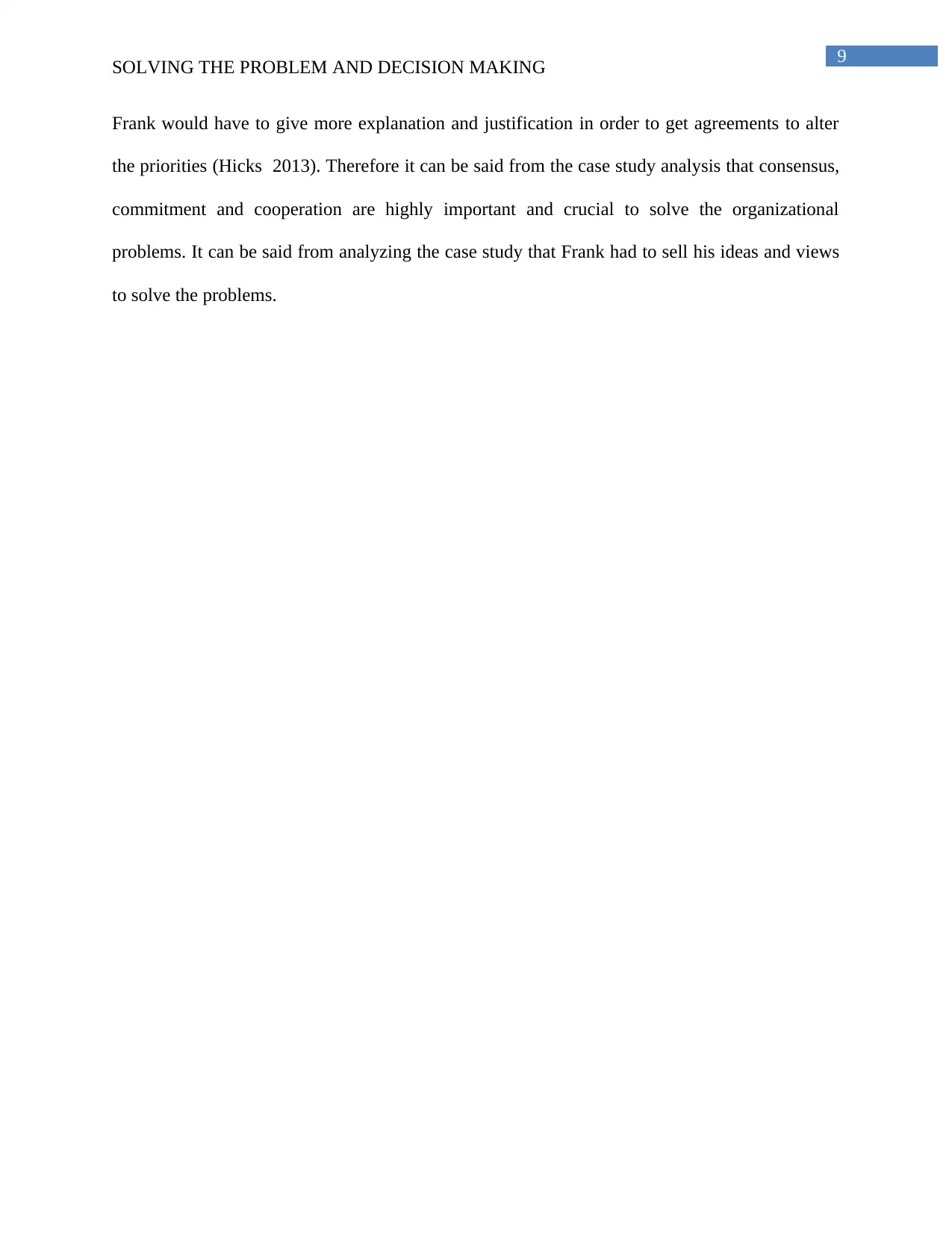
9
SOLVING THE PROBLEM AND DECISION MAKING
Frank would have to give more explanation and justification in order to get agreements to alter
the priorities (Hicks 2013). Therefore it can be said from the case study analysis that consensus,
commitment and cooperation are highly important and crucial to solve the organizational
problems. It can be said from analyzing the case study that Frank had to sell his ideas and views
to solve the problems.
SOLVING THE PROBLEM AND DECISION MAKING
Frank would have to give more explanation and justification in order to get agreements to alter
the priorities (Hicks 2013). Therefore it can be said from the case study analysis that consensus,
commitment and cooperation are highly important and crucial to solve the organizational
problems. It can be said from analyzing the case study that Frank had to sell his ideas and views
to solve the problems.
Secure Best Marks with AI Grader
Need help grading? Try our AI Grader for instant feedback on your assignments.
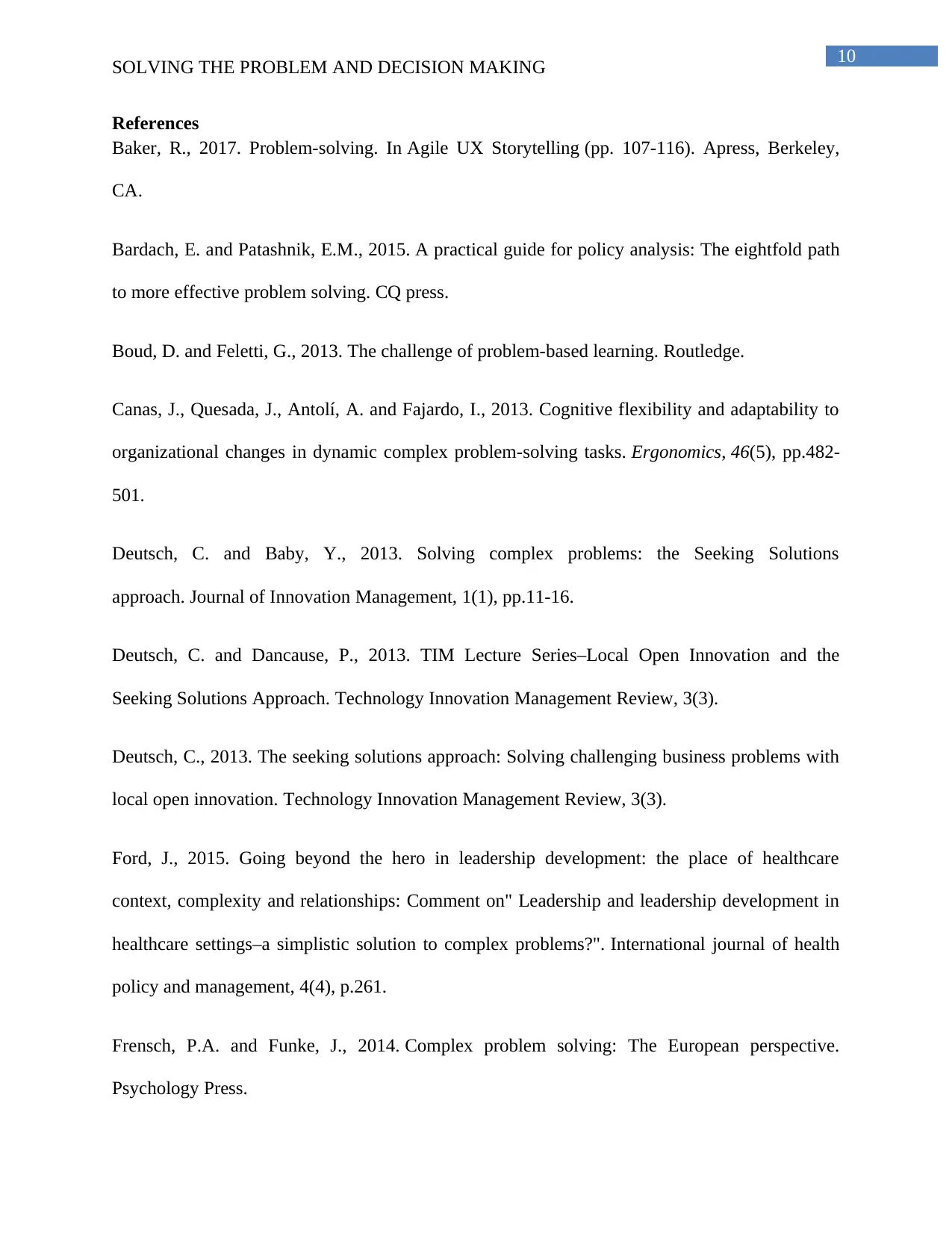
10
SOLVING THE PROBLEM AND DECISION MAKING
References
Baker, R., 2017. Problem-solving. In Agile UX Storytelling (pp. 107-116). Apress, Berkeley,
CA.
Bardach, E. and Patashnik, E.M., 2015. A practical guide for policy analysis: The eightfold path
to more effective problem solving. CQ press.
Boud, D. and Feletti, G., 2013. The challenge of problem-based learning. Routledge.
Canas, J., Quesada, J., Antolí, A. and Fajardo, I., 2013. Cognitive flexibility and adaptability to
organizational changes in dynamic complex problem-solving tasks. Ergonomics, 46(5), pp.482-
501.
Deutsch, C. and Baby, Y., 2013. Solving complex problems: the Seeking Solutions
approach. Journal of Innovation Management, 1(1), pp.11-16.
Deutsch, C. and Dancause, P., 2013. TIM Lecture Series–Local Open Innovation and the
Seeking Solutions Approach. Technology Innovation Management Review, 3(3).
Deutsch, C., 2013. The seeking solutions approach: Solving challenging business problems with
local open innovation. Technology Innovation Management Review, 3(3).
Ford, J., 2015. Going beyond the hero in leadership development: the place of healthcare
context, complexity and relationships: Comment on" Leadership and leadership development in
healthcare settings–a simplistic solution to complex problems?". International journal of health
policy and management, 4(4), p.261.
Frensch, P.A. and Funke, J., 2014. Complex problem solving: The European perspective.
Psychology Press.
SOLVING THE PROBLEM AND DECISION MAKING
References
Baker, R., 2017. Problem-solving. In Agile UX Storytelling (pp. 107-116). Apress, Berkeley,
CA.
Bardach, E. and Patashnik, E.M., 2015. A practical guide for policy analysis: The eightfold path
to more effective problem solving. CQ press.
Boud, D. and Feletti, G., 2013. The challenge of problem-based learning. Routledge.
Canas, J., Quesada, J., Antolí, A. and Fajardo, I., 2013. Cognitive flexibility and adaptability to
organizational changes in dynamic complex problem-solving tasks. Ergonomics, 46(5), pp.482-
501.
Deutsch, C. and Baby, Y., 2013. Solving complex problems: the Seeking Solutions
approach. Journal of Innovation Management, 1(1), pp.11-16.
Deutsch, C. and Dancause, P., 2013. TIM Lecture Series–Local Open Innovation and the
Seeking Solutions Approach. Technology Innovation Management Review, 3(3).
Deutsch, C., 2013. The seeking solutions approach: Solving challenging business problems with
local open innovation. Technology Innovation Management Review, 3(3).
Ford, J., 2015. Going beyond the hero in leadership development: the place of healthcare
context, complexity and relationships: Comment on" Leadership and leadership development in
healthcare settings–a simplistic solution to complex problems?". International journal of health
policy and management, 4(4), p.261.
Frensch, P.A. and Funke, J., 2014. Complex problem solving: The European perspective.
Psychology Press.
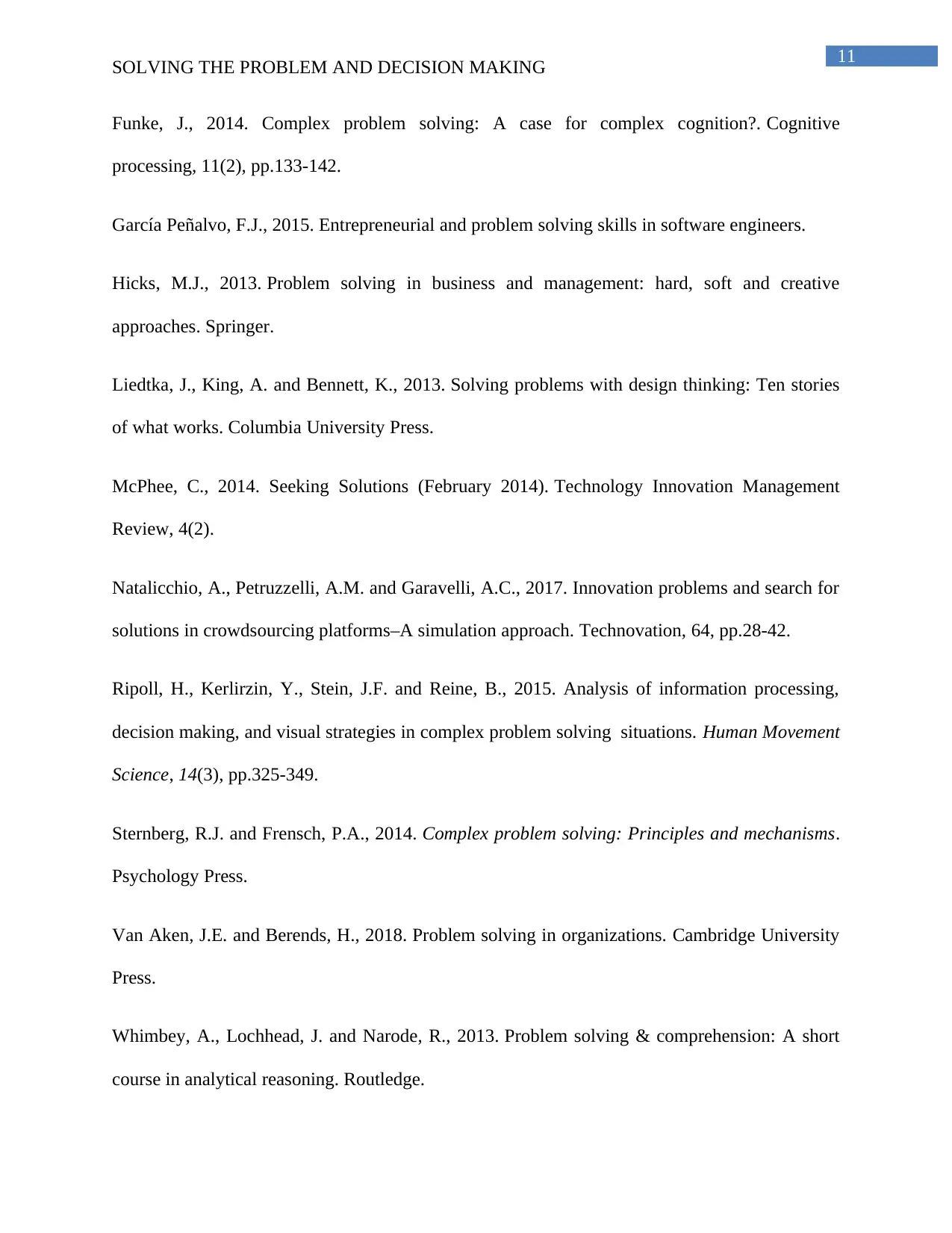
11
SOLVING THE PROBLEM AND DECISION MAKING
Funke, J., 2014. Complex problem solving: A case for complex cognition?. Cognitive
processing, 11(2), pp.133-142.
García Peñalvo, F.J., 2015. Entrepreneurial and problem solving skills in software engineers.
Hicks, M.J., 2013. Problem solving in business and management: hard, soft and creative
approaches. Springer.
Liedtka, J., King, A. and Bennett, K., 2013. Solving problems with design thinking: Ten stories
of what works. Columbia University Press.
McPhee, C., 2014. Seeking Solutions (February 2014). Technology Innovation Management
Review, 4(2).
Natalicchio, A., Petruzzelli, A.M. and Garavelli, A.C., 2017. Innovation problems and search for
solutions in crowdsourcing platforms–A simulation approach. Technovation, 64, pp.28-42.
Ripoll, H., Kerlirzin, Y., Stein, J.F. and Reine, B., 2015. Analysis of information processing,
decision making, and visual strategies in complex problem solving situations. Human Movement
Science, 14(3), pp.325-349.
Sternberg, R.J. and Frensch, P.A., 2014. Complex problem solving: Principles and mechanisms.
Psychology Press.
Van Aken, J.E. and Berends, H., 2018. Problem solving in organizations. Cambridge University
Press.
Whimbey, A., Lochhead, J. and Narode, R., 2013. Problem solving & comprehension: A short
course in analytical reasoning. Routledge.
SOLVING THE PROBLEM AND DECISION MAKING
Funke, J., 2014. Complex problem solving: A case for complex cognition?. Cognitive
processing, 11(2), pp.133-142.
García Peñalvo, F.J., 2015. Entrepreneurial and problem solving skills in software engineers.
Hicks, M.J., 2013. Problem solving in business and management: hard, soft and creative
approaches. Springer.
Liedtka, J., King, A. and Bennett, K., 2013. Solving problems with design thinking: Ten stories
of what works. Columbia University Press.
McPhee, C., 2014. Seeking Solutions (February 2014). Technology Innovation Management
Review, 4(2).
Natalicchio, A., Petruzzelli, A.M. and Garavelli, A.C., 2017. Innovation problems and search for
solutions in crowdsourcing platforms–A simulation approach. Technovation, 64, pp.28-42.
Ripoll, H., Kerlirzin, Y., Stein, J.F. and Reine, B., 2015. Analysis of information processing,
decision making, and visual strategies in complex problem solving situations. Human Movement
Science, 14(3), pp.325-349.
Sternberg, R.J. and Frensch, P.A., 2014. Complex problem solving: Principles and mechanisms.
Psychology Press.
Van Aken, J.E. and Berends, H., 2018. Problem solving in organizations. Cambridge University
Press.
Whimbey, A., Lochhead, J. and Narode, R., 2013. Problem solving & comprehension: A short
course in analytical reasoning. Routledge.
1 out of 12
Related Documents
Your All-in-One AI-Powered Toolkit for Academic Success.
+13062052269
info@desklib.com
Available 24*7 on WhatsApp / Email
![[object Object]](/_next/static/media/star-bottom.7253800d.svg)
Unlock your academic potential
© 2024 | Zucol Services PVT LTD | All rights reserved.




